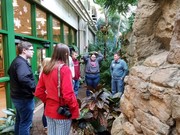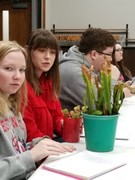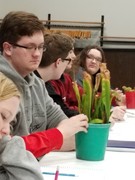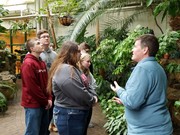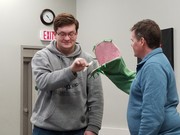Botany Class Visited the Quad Cities Botanical Garden
On Friday, February 28th the Botany class visited the Quad Cities Botanical Garden in Rock Island, IL. While there, the students attended 3 lectures. The first was on Carnivorous Plants, the second on The Rainforests and the third was on Life of the Mississippi River. Written descriptions of the sessions by students are below.
Carnivorous Plants by Emma.
The plants use nectar guides to lure the insect in. The Butterworf has sticky leaves that catch insects and eat them. Sundews have digestive enzymes that are visible. Some have tooth-like structures to catch prey. Pitcher plants are found everywhere in the world. We have them in Illinois and even Iowa. They have tiny hair-like structures that make it easy for the prey to slide down and hard for them to escape. Venus Fly Traps originate from North to South Carolina. They were found by Myrtle Beach.
Life in the Rainforest by John.
Tropical plants don’t have deep root systems but instead they have wide base roots for stability. Some plants are sensitive to touch and will close when exposed to touch or when there is an absence of light. Rainforests provide the world with 20% of the world’s oxygen. There are still tons of undiscovered species of plants located in the rainforests. Some tropical plants are used in food coloring and medicines.
Mississippi River Life by DJ.
The Mississippi is the 4th longest river in the world. It is also the largest wildlife rescue in the country, and gets more visitors than Yellowstone national park and the Grand Canyon. The river supports many different factories and businesses. However, the river is threatened by pollution. Mussels that live in the river keep it clean by filtering 10 gallons of water a day each. The Mississippi is very susceptible to different types of invasive species, such as plants and animals, while being a haven for many creatures the Mississippi is a very fragile ecosystem that needs to be protected.




